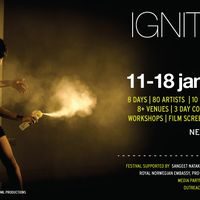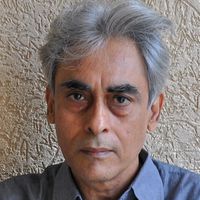Talking Dance in India

Central to the dialogues on the future of Indian contemporary dance at the Festival was the notion of an emerging ‘community’ of practitioners and the felt need for an Indian dance network to address common concerns and facilitate exchange. It is in this context that Conceiving Connections was organised as a network seminar to enable dance initiatives in India, dancers, choreographers, researchers, arts administrators, funders and policy makers to “think collectively about the possibilities of a network”, in the words of art critic Sadanand Menon, who mediated the dialogue.
Commissioned by the Goethe Institut, Max Mueller Bhawan, New Delhi, the day-long seminar was organised in two parts on 13 November 2010: a plenary focusing on the notion of networks followed by brainstorming sessions on key issues of relevance for the dance community in India.
The triad of practice, research and documentation
Mediator Sadanand Menon set the tone with his keynote address that briefly traced the history of the modern movement in Indian dance from the 1920s through the era of the icons from Uday Shankar and Mrinalini Sarabhai to Chandralekha. Acknowledging the growing innovation and self-assurance among Indian contemporary dancers in the last decade, Mr. Menon raised the all-important question: what do we want for Indian contemporary dance?
The urgent needs for archiving and academic research on dance were underlined in his address. “Performance work cannot grow in isolation,“ Mr. Menon reminded the audience, pointing to the lack of formal Dance Studies programmes in universities in India, where dance continues to be studied in the traditional way with a guru (teacher). Within the traditional system, focus on theory is often limited. Mr. Menon stressed that academic study on dance should be developed in parallel to artistic creation and that such research would serve as an aid for self-reflexivity.
The plenary that followed gathered five speakers representing academia, artists, funders and networks to explore the opportunities and challenges in establishing networks.
Need for policy engagement
Scholar Anita Cherian examined State policies and forms of support available to dance and performance art in India in the light of the felt need to create a network for support and integration.
Why networks fail
Drawing from his experience with two networks (Theatre Laboratory Network and Archives Resource Community), Anmol Vellani, Executive Director, India Foundation for the Arts discussed the nature of networks laying emphasis on structure, funding, activities and reach. In an insightful analysis on why networks fail, Mr. Vellani highlighted the critical role played by common cause (as against competing agendas) in the success of a network. Striking the right balance between ‘leaders’, ‘participants’, ‘freeloaders’ and ‘floaters’ within the network membership was emphasised. Mr. Vellani also highlighted the danger inherent in establishing networks with external support as such projects often tend to be donor/funding-driven, thus challenging a successful transition to sustainability (both financial and motivational).
Do we support each other?
Another panelist, Vikram Iyengar, Artistic Director of the Kolkata-based Ranan Performance Collective asked what, how and why: “What is a network? What can it be? Do we need a network?” He went on to explore the notion of community (“Do we support each other? Do we serve support? Who is this ‘we’?) and the issue of representation (“Who represents us to any powers that be? Who should represent us? Who decides?”). He also raised the issue of the real/perceived divide between contemporary and classical dancers in India. Would classical dancers be part of the proposed network, he wondered.
Mr. Iyengar went on to discuss the connections (or lack thereof) between the dance sector and other genres as well as policy makers, arguing that proposed network might serve as a ‘common voice’ when talking to governments and other artists within India and dance communities abroad.
Connecting governments and civil society
The Asia-Europe Foundation (ASEF) - represented by this writer - presented its work in connecting dancers in 43 countries in Asia and Europe through its Pointe-to-Point: Asia-Europe Dance Forum between 2003 and ’09. Focus also rested on ASEF’s unique role in connecting civil society concerns with governments through its engagement with the Asia-Europe Meeting. The possibilities of Culture360.org as a platform for information exchange and dialogue was also discussed.
Networks in India and south Asia
The last panelist, Sanjna Kapoor, Director of Prithvi Theatre, Mumbai shared her experience in setting up the India Theatre Forum, which was initiated as a network of theatre practitioners across India.
Participating artists and administrators shared further experiences. Pooja Sood, Director, Khoj International Artists’ Association, New Delhi spoke of the South Asian Network for the Arts (SANA), which was established in response to the need for regional connections and which achieved its goals though its sustainability was connected to funding support. Mediator Sadanand Menon endorsed this ‘need to respect entropy’. The network comes together to perform a set of common tasks agreed upon but is not an ‘immortal entity’, he reminded the audience.
Ms. Sood also highlighted the ‘stellar network’ model explored by Khoj that has enabled the establishment of ‘sub-organisations’ such as Desire Machine Collective@Khoj Guwahati and 1, Shanti Road in Bangalore, which are neither Khoj branches nor networks, but serve as local/regional hubs supported and seeded by Khoj.
Singapore-based independent dramaturge, Fukuen Tang identified flexibility as being the core strength of a network. He foregrounded validity, relevance and legitimacy as being of primary significance in evaluating and sustaining networks.
The post-lunch brainstorming session was designed as a laboratory that focused on five issues identified through a consultation process with the Indian dance community: funding; network activities; structure of networks; policy making; and, creating a network.
Mr. Jawhar Sircar, Secretary, Ministry of Culture, Government of India joined the deliberations of the brainstorming session and highlighted the existing government schemes and grants in support of performing arts, many of which were not known to the participating artists. In particular, he mentioned the Salary, Production and Cultural Functions Grant schemes. He also invited the participants to provide inputs on the draft policy of the proposed Cultural Mega Festivals scheme, on which the Ministry of Culture is currently conducting a public consultation with stakeholders.
Next steps
By facilitating the conversation on communities and networks through Conceiving Connections, the Gati Dance Forum has taken the important first step. It remains to be seen how the emerging community of dance practitioners in India will continue this journey in the months ahead and, significantly, the destination they will choose for themselves.
The Ignite! Festival of Contemporary Dance was supported by ASEF through the Asia-Europe Cultural Partnership Initiatives programme.
Anupama Sekhar is Project Manager for Cultural Exchange at the Asia-Europe Foundation.
Similar content
from - to
10 Nov 2010 - 13 Nov 2010
from - to
11 Jan 2015 - 18 Jan 2015
16 Mar 2011
from - to
02 Nov 2011 - 12 Nov 2011
25 Apr 2017






